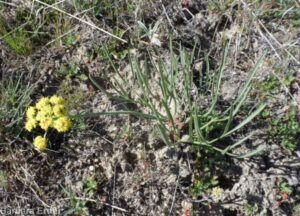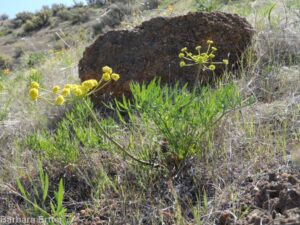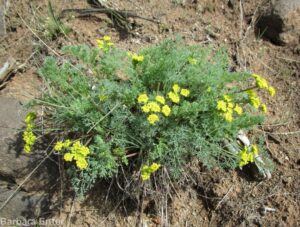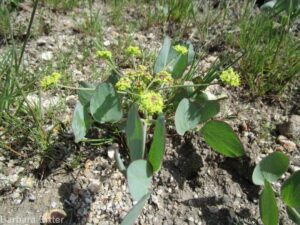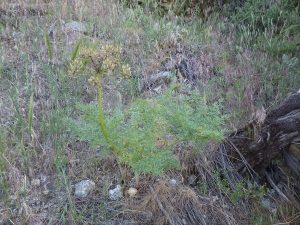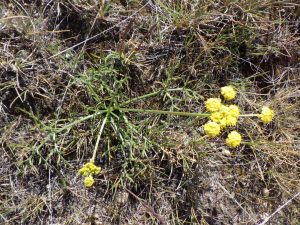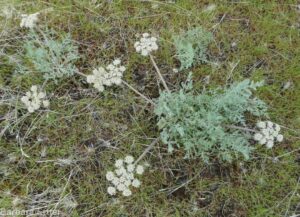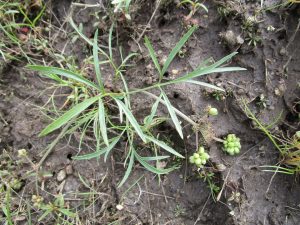Even for those of us inured to the inevitability of name changes, and fully versed on the perfectly good reasons behind them, the nearly complete turnover in the nomenclature of our local biscuitroots (genus Lomatium) can be mind-boggling. For those of you who haven’t been keeping track, here’s a current synopsis, with the what’s and why’s, including a behind-the-scenes glimpse at what all those pesky plant taxonomists are up to.
First, it is important to note that this group of plants is extremely important, both for food and medicine, to most of the Native American tribes within whose traditional territories the many different species of biscuitroot occur (note: although the English common name of “biscuitroot” is sometimes restricted to only those species with enlarged edible roots, which were, and still are, a significant food source for many tribes, I am using this as the common name for the genus Lomatium in general; desert parsley is an alternate common name). Each tribal language group has its own name, or names, for subunits of Lomatium, with the subunits often based more on specific use than necessarily coinciding with current scientific nomenclature. One of these names, “cous” (rhymes with “house”), is one of the few examples where a Native American name was incorporated into the scientific name: Lomatium cous, which does not occur in the Boise Front. The names given by the Shoshone, Bannock, Paiute, and other tribes to those species that do occur in the Boise Front, and the uses of these plants, should be respected as their traditional intellectual property.
As currently defined by science, Lomatium is a large genus that has undergone rapid evolutionary radiation in western and central North America. Over the last century, taxonomic treatments of the genus have gone through several cycles of expansion and contraction, with major chunks sometimes treated as separate genera (e.g., Cogswellia, Leptotaenia, Peucedanum). The number of species within the currently inclusive Lomatium is a moving target, with new species being described (or “resurrected” from synonymy) on a regular basis. In 1997, Intermountain Flora provided a conservative estimate of “about 70”, but over 100 are currently in the draft treatment for Flora of North America (B. Wilson, pers. comm. 2023).
A major reason for all this nomenclatural activity is because several independent teams have recently homed in on Lomatium as a worthy research topic, rich in previously under-appreciated diversity that is amenable to analysis with the burgeoning new tools in the taxonomic toolkit. One of these teams is centered here in the Treasure Valley, spearheaded by Dr. James F. Smith at Boise State University and Dr. Don Mansfield at The College of Idaho. Their students and other collaborators have integral roles in the research, currently aided by a major NSF grant.
The genus itself is replete with narrow endemics (i.e., species that occur in a very restricted geographic area, often confined to a specific geologic substrate or soil type), many of conservation concern. However, many of these species look very similar superficially, with clusters of small yellow flowers and leaves divided into narrow lobes; their morphological distinctiveness only becomes apparent when other features are carefully examined. Molecular phylogenetic analysis has accordingly been invaluable, especially when combined with morphometric evaluation, extensive field studies, soil analyses, and other techniques. None of these are “magic bullets” by themselves, but when combined with one another, and with traditional taxonomic approaches, they can bring biodiversity patterns to light that had not previously been evident, including new species.
With this background in hand, what exactly has been going on with biscuitroots in the Boise Front? Here’s the run-down:
What’s the story with Nineleaf Biscuitroot?

Most wildflower guides and apps will lead you to believe that the most common biscuitroot in the Boise Front is the nine-leaf biscuitroot, Lomatium triternatum. Until recently, the primary technical floras (e.g., Vascular Plants of the Pacific Northwest, Intermountain Flora) also placed most of these plants in Lomatium triternatum, but specifically in the subspecies platycarpum. This is the most commonly encountered biscuitroot in relatively sandy and loamy soils, easily recognized by its blue-green leaves that are commonly divided into nine narrow segments.
As happens, initial molecular phylogenetic analysis showed that ssp. platycarpum was not all that closely related to ssp. triternatum, and the two should therefore be treated as separate species — which is what some even earlier floras (e.g., Illustrated Flora of the Pacific States) had actually done. Because of the rules of botanical nomenclature, the correct name for these plants at the species rank is Lomatium simplex, not platycarpum, and so this is now the correct name for most of what we had been accustomed to calling L. triternatum, at least in the Boise Front. For the record, yes, we really do use the term “resurrecting” when an existing name that had been relegated to synonymy under an older inclusive name is deemed to be distinct after all.
Ok, that takes care of ssp. platycarpum, but what about the rest of Lomatium triternatum? Well, now the story really gets tricky, in that there turns out to be a lot of subtle variation within what had been ssp. triternatum, which had actually been divided into two varieties: triternatum and anomalum. Oh, and let’s not forget the closely related Lomatium ambiguum from central Idaho and the recently described L. packardiae from nearby Oregon. As a further complication, it took a significant amount of sleuthing and fieldwork to nail down exactly which of the multiple possibilities was the REAL L. triternatum, all based on a scrappy specimen collected by the Lewis & Clark Expedition somewhere on the “Kooskooske” (Clearwater) River. (See Smith et al. 2018 and “Lewis’s Lost Lomatium Found” by Michael Ottenlips).
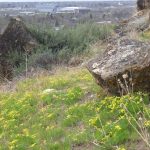
On top of which, it’s been a toss-up as to whether one of our other common biscuitroots in the lower Foothills, which often forms dense stands on heavy clay soils (e.g., Chief Eagle Eye Reserve, Foothills East Reserve), is best treated as L. triternatum var. anomalum or L. ambiguum (with the names themselves giving a clue to the challenges of biscuitroot identification!) Well, guess what? It turns out to be neither one, but instead a previously overlooked species! Given the prominence of the new species in the hills overlooking the state’s largest city, and the bottleneck of available funding to continue research on the genus, the team decided to try an innovative fund-raising option that had been used successfully elsewhere: they auctioned off the naming rights for the new species. The winning bid chose to use the opportunity to honor Cecil D. Andrus, so this element of the baffling Lomatium triternatum complex is now officially known as Lomatium andrusianum, or Andrus’s biscuitroot (Stevens et al. 2018).
Next Up: Butterflies as Botanists

Another conspicuous biscuitroot in the Boise Front, especially along Currant Creek north of Hidden Springs, is easily recognized by its finely divided bluish green leaves with a strong cilantro-scent. Wildflower guides and apps will probably tell you this is Gray’s biscuitroot (Lomatium grayi), and this was in fact correct . . . until 2018. That’s how long it took for a different team working on Lomatium to realize that at least three distinct species were shoehorned together under the same name (Alexander et al. 2018).
Well, at least that’s how long it took humans to figure it out; swallowtail butterflies had already known there were several species involved, and they used some but not others as host plants for their caterpillars. It was actually an entomologist who first homed in on this lepidopteran behavior and cued the botanists in. The name chosen for the most widespread component of chopped-up Lomatium grayi, which is the one occurring in the Boise Front, is Lomatium papilioniferum, with the epithet translating as “butterfly-bearing” (Papilio being the genus name for swallowtail butterflies). Although iNaturalist uses “pungent desert parsley” as a common name, “butterfly biscuitroot” is both more euphonious and a tie to the delightful backstory.
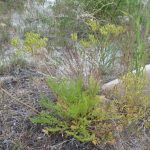
As for Lomatium grayi itself, it’s still a perfectly good species, just not the one occurring in the Boise Front. In fact, it only barely enters southeastern Idaho, with most populations occurring further south and/or east. As you can see from this photos, leaves are greener, shorter, and less “fluffy” than in L. papilioniferum, at least in this population north of Preston. How fun that it took butterflies to make us take a more careful look!
Mostly the Same . . . For Now
The other biscuitroots occurring in the Boise Front still retain their previous names, with some reshuffling between varietal and species names. This, however, could easily change, depending on all the new results flooding in from the various Lomatium teams; all I can say at this time is, hold on to your hats! For now, here’s the most up-to-date synopsis I’m aware of:
- Barestem biscuitroot (Lomatium nudicaule): This is a another relatively common species throughout the Foothills, and the easiest to identify with its distinctive round blue-green leaflets. A delightful alternate common name is pestle-parsnip, probably due to the swollen apex of the stem. If any nomenclatural surprises are in the works, I’m not aware of them.
- Fernleaf biscuitroot: Previously known as Lomatium dissectum var. multifidum, now just plain L. multifidum. This is the largest of our locally occurring biscuitroots, with reddish brown flowers that fade with age. It is mostly missing from the Foothills proper but still fairly common at higher elevations, and particularly abundant in the basalt talus along Highway 21/Mores Creek. Although fernleaf biscuit is currently in vogue for both culinary and medicinal purposes, please keep in mind that any thoughts of harvesting should be balanced against the continued existence of our local populations already in decline from other threats, any legal restrictions on collecting, and the priority of indigenous rights to a culturally significant plant.
- Gumbo or Wasatch biscuitroot: The jury is still out as to whether this is best treated as Lomatium bicolor var. leptocarpum (which is what is what I’m using for now) and plain Lomatium leptocarpum (as used in Intermountain Flora). Locally it is only known from south of the Boise River, especially along the Oregon Trail below Bonneville Point. It differs from the more widespread Lomatium simplex in having more irregularly divided leaves with shorter, greener segments, and also in its more spreading habit.
- Bigseed biscuitroot (Lomatium macrocarpum): This is another species known locally only from south of the Boise River, most readily found in the Oregon Trail Recreation Area. It is easily recognized, at least when in bloom, by the large white inflorescences and lacy blue-green leaves. Nomenclaturally stable, at least for now.
And One to Add!
The diminutive turkey-pea is one of the contenders for the earliest wildflowers to bloom in later winter, with sagebrush buttercup (Ranunculus glaberrimus) as the primary competition. The inconspicuous low-lying clusters of white flowers and leaves divided into a few narrow leaflets are within the range of morphological variation of Lomatium, but the globular fruit of turkey-pea differ from the diagnostic flattened fruit of typical Lomatium, with the result that turkey-pea had traditionally been placed in a separate genus as Orogenia linearifolia. However, one of the side results of the molecular phylogenetic revolution has been an essentially philosophical shift as well, emphasizing cladistic relationships as paramount in classification independent of unique evolutionary adaptions in an embedded lineage, or how disruptive its inclusion might be to an otherwise morphologically coherent genus (sorry, no way to explain this in simpler terms without an entire separate essay!) Unsurprisingly, the evidence now unequivocally shows that Orogenia linearifolia is nested within (or originated from) the Lomatium clade, and by the currently ascendant philosophy is therefore a Lomatium. As a result, we can add Lomatium linearifolium to the list of biscuitroots present in the Boise Front, though I will continue using “orogenia” as a common names, along with turkey-pea.
Anyway, that’s what I can tell you about biscuitroots in the Boise Front, at least for now, which I hope has also served as a window into why names keep changing. In essence, as much as we crave to have nature presented to us as tidy, definitely named chunks, the reality is that a) nature doesn’t really care what we want, and b) our scientific knowledge of exactly what is “out there”, and how best to package it for general consumption, is constantly being refined. Although not generally appreciated as such, species are fundamentally hypotheses, which are often initially proposed on scanty evidence (e.g., “Lewis’s Lost Lomatium”) and then subsequently supported, undermined, and/or modified as new information comes to light, ranging from basic observational data in the field to sophisticated technological analysis in the laboratory. The result being that you, the user community, has the joy, and frustration, of a seemingly never-ending bounty of new species and names to try to keep on top of; stay tuned, and go with the flow!
Alexander, J. A., W. Whaley, & N. Blain. 2018. The Lomatium grayi complex (Apiaceae) of the western United States: a taxonomic revision based on morphometric oil composition and larva-host coevolution studies. Journal of the Botanical Research Institute of Texas 12(2): 387-444.
Ottenlips, M. 2019. Lewis’s Lost Lomatium Found. Sage Notes 41(1): 1, 7. https://idahonativeplants.org/wp-content/uploads/2019/03/SageNotesMarch2019.pdf
Smith, J., D.H. Mansfield, M. Stevens, E. Sosa, M.A.E. Feist, S.R. Downie, G. Plunkett, & M. Darrach. 2018. Try, tri again? Resolving species boundaries within Lomatium triternatum (Apiaceae) complex using molecular phylogenetic tools. J. Syst. Evol. 58(3):218–230.
Stevens, M., D.H. Mansfield, J.F. Smith, and M.E. Feist. 2018. Resolving the anomaly of Lomatium anomalum: Discovery of a new species in southwestern Idaho (U.S.A.), Lomatium andrusianum (Apiaceae). J. Bot. Res. Inst. Texas 12(1): 1 – 15.
